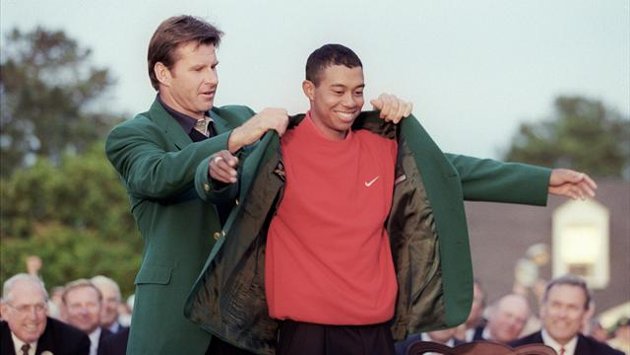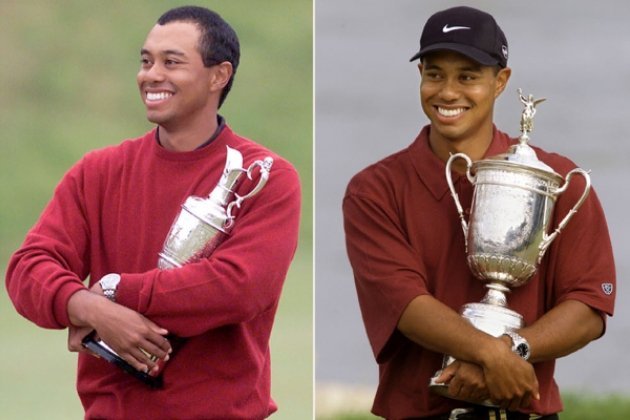Nick Faldo slipped the Green Jacket onto Tiger Woods for the first time when Tiger Woods won the 1997 Masters by a record 12 shots at the age of just 21, playing a brand of power golf that the world had never seen, it seemed that the most unbreakable of golf’s records was under threat at last. Nobody had ever looked like challenging Jack Nicklaus’ record of 18 Major championship victories, but Woods’s vast potential made it seem possible at last. Over the next decade he collected Majors at a rate faster than some of the best in the world collect ordinary tournaments (Sergio Garcia has just eight US Tour wins, for example).
So when the final putt dropped to give Woods a play-off victory at the US Open in 2008, the idea that he would beat Nicklaus’ record seemed not just possible, but inevitable. At the time, that victory gave Woods his 6th Major in the space of three and a half seasons; that’s the same number of Majors won by Nick Faldo and Lee Trevino managed in their entire careers. And that’s just the start of it. As well as winning six of those previous 14 Majors, he came second in four, third in one and fourth in one. The other two? He tied for 12th in one of them, and missed the cut in the other (that was the 2006 US Open, which took place just a few weeks after the death of his father). In short, the sport of golf had never seen such a sustained run of brilliance in the game’s big events.
Yet fast forward 6 years, and Woods has never looked less likely to surpass Nicklaus’ record of 18 Majors, even before the world number one revealed he had back surgery and would miss the Masters. The clock has been ticking ever louder on Woods’s quest to catch Nicklaus through his six-year Major title drought since winning the 2008 US Open, and the climb has grown steeper with time and championship opportunities slipping away. Four-time Masters winner Woods, stuck on 14 Majors, had back surgery for a pinched nerve on Monday and will be missing the trip to Augusta National for the first time since appearing in 1995 when he was a 19-year-old amateur. And the magic Nicklaus number 18 could haunt Woods during his recovery as his absence from the Masters will stretch his Majors drought to 18 events with serious questions still to be answered about his playing future.
The 38-year-old Woods, who won five times in 2013 but failed to play his best in the Majors, remains hopeful he will be back competing at his world number one level by mid-2014. “It’s tough right now, but I’m absolutely optimistic about the future,” said Woods, whose back pain surfaced last year and intensified this season leading to a retirement at last month’s Honda Classic and his skipping the Arnold Palmer Invitational.
Swing changes and personal issues cost Woods opportunities in the past, but the mounting time lost to injuries could be a final blow that derails the dominant golfer of his generation. Woods’s injury history began with a troublesome left knee, first operated on when he was a freshman at Stanford University in 1994. Three more operations on that knee have followed. Injuries to his ankle and neck, his right and left Achilles’ tendons and fractures in his leg, which he played through in winning the 2008 US Open in a 19-hole playoff against Rocco Mediate, have held up his pursuit of the Golden Bear Nicklaus. He skipped two Opens, one US Open and one PGA Championship since 2008 because of injury. Now he must deal with a bad back, the bane of many golfers who have suffered ailments from the game’s repetitive twisting and torqueing pressure, including Nicklaus himself.
By the chronological clock, Woods has stayed level with Nicklaus at a comparable age, but Nicklaus registered Major win number 15 with his Open championship at age 38 in 1978. Nicklaus added the US Open and US PGA crowns in 1980 at age 40 before capping his legendary career with one last thrilling Masters title at age 46 in 1986. The Golden Bear, however, was not under the pressure of a record-setting chase. Nicklaus had long since taken over as the premier winner of the Majors, having broken Walter Hagen’s record of 11 with his 1973 victory in the PGA Championship. But Woods likes a good challenge, and golf’s greatest player since the days of Nicklaus is not about to give up. In addition to surpassing Nicklaus, Woods has also long targeted the 82 career victories piled up on the PGA Tour by Sam Snead. “There are a couple (of) records by two outstanding individuals and players that I hope one day to break,” Woods said. “As I’ve said many times, Sam and Jack reached their milestones over an entire career. I plan to have a lot of years left in mine.”
Beyond his own physical concerns is the advance of talented younger players. During Woods’ absence from the winner’s circle at the Majors, other players have emerged including Northern Ireland’s Rory McIlroy, Englishman Justin Rose and Australian Adam Scott, winner of the 2013 Masters. Scott said younger players certainly respected and admired Woods, but were not intimidated about competing with him. “I think my generation of player is feeling like their time is now, so they have got to take advantage of it,” Scott said earlier this year in a conference call about his Masters defence.
The end of Woods’s aura can probably be traced back to 2009 US PGA Championship, when the superstar failed to win a Major while leading at the 54-hole stage for the first time in his career. Just three months later, he crashed his car into a tree outside his house after an argument with then-wife Elin on Thanksgiving. The rest of that story is history. But are Tiger’s days of winning Majors history as well? And even if he does still have some Majors left in him, does he have enough to surpass Nicklaus? Winning five of golf’s biggest prizes would have seemed simple to a 1997 or 2008 vintage Tiger Woods. Not any more, though. To tie Nicklaus’s record, Woods needs four Majors – as many as Ernie Els has managed in 20 years at the top of the game. And to beat Nicklaus’s record, Woods needs five which is as many as Seve Ballesteros managed in one of golf’s most glorious careers. Considering the fierce competition he faces, and the state of his joints and bones after 20 years of constant golf, it looks as if the Golden Bear’s unbeatable record, which looked so vulnerable just a few years ago, might prove to be unbeatable after all.
Source: Eurosport.



